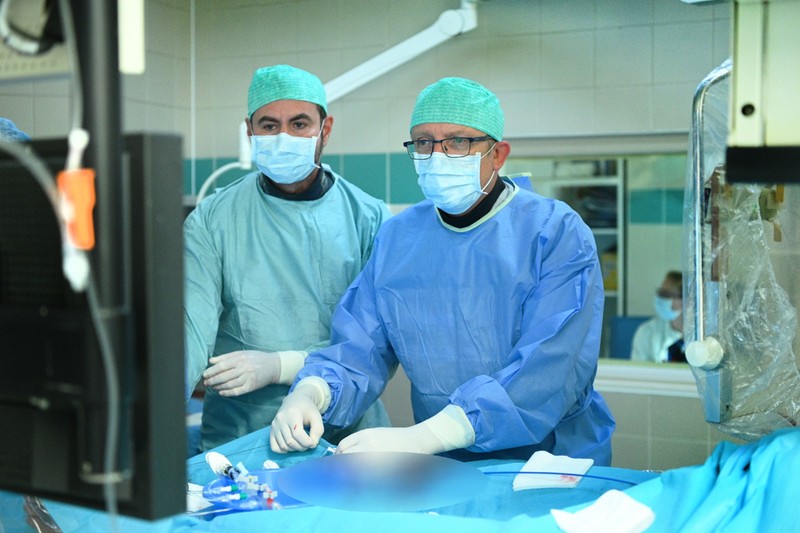At the Clinical Center of the University of Debrecen, most balloon angioplasty (BPA) is performed in Hungary. The complex catheter intervention was used in 2017 – for the first time in Hungary – at the Cardiology and Heart Surgery Clinic. Since then, specialists in Debrecen have performed about sixty balloon dilatations in patients with chronic thromboembolic pulmonary hypertension (CTEPH). After the treatment, the patient’s quality of life improves significantly, their complaints of suffocation decrease and their physical load capacity increases.
Chronic thromboembolic pulmonary hypertension (CTEPH) develops in a part of patients who have previously suffered a pulmonary embolism (pulmonary embolism), up to 8-12 percent. Despite the blood thinner used in the treatment of pulmonary embolism, blood clots (embolus) remain in the pulmonary arteries, which prevent the smooth flow of blood, causing an increase in pressure in the right side of the heart. The main complaint of patients is suffocation. A special method of treating the disease is balloon pulmonary vasodilation (BPA), which was first used in our country six years ago at the Clinical Center of the University of Debrecen.
During the procedure, the obstruction to the flow is mitigated by expanding the organ blood clots that obstruct the blood flow in the lungs, so the pressure in the pulmonary vessels decreases, along with the load on the heart. Thrombi are approached through the right side of the heart. A thin, special wire is passed through the catheter through the blood clot and it is expanded with a balloon
– told László Balogh, a clinical specialist at the Cardiology and Cardiac Surgery Clinic of the UD Clinical Center.
Since 2017, most interventions in Hungary have been performed at the Cardiology and Heart Surgery Clinic, and around sixty successful balloon pulmonary vasodilatations have already been performed by the specialists of the University of Debrecen.
Several interventions are usually necessary for one patient, because emboli can remain in many branches of the pulmonary arteries, and even eighteen or twenty blood clots can form. The more severe the case, the more sessions we perform all the dilations. Since the first BPA in Hungary, so much has changed in the technique that today we try to eliminate as many blockages as possible in one session with balloons that are undersized compared to the original diameter of the vessel. Thus, instead of the previous five or six sessions, we perform the dilation in three or four sessions. We strive to cautiously increase the flow and at the same time gradually reduce the pressure
– emphasized Assistant Professor Tibor Szük, a specialist in the Department of Cardiology and Cardiac Surgery at the UD Clinical Center.
The more effective the intervention, the sooner it becomes clear that chronic thromboembolic pulmonary hypertension (CTEPH) is behind the suffocation complaints. A thorough examination is required to establish the diagnosis.
In the case of a complaint of suffocation, the family doctor usually first sends the patient to pulmonary medicine. However, basic examinations cannot diagnose this disease. An isotopic examination of the lungs is much more suitable for this, which shows the residual blood clot, because in this case the isotope injected into the peripheral circulation is distributed patchily in the lungs. We also perform an echocardiogram, and an invasive catheter examination is very important to measure how much the pressure in the right side of the heart has increased. After that, the specialists perform pulmonary artery staining, which makes the exact location of the blockage visible
– explained assistant professor Andrea Daragó, a specialist in the Department of Cardiology and Cardiac Surgery at the UD Clinical Center.
After the operation, a chest X-ray and echocardiogram are performed, and the right heart pressure and heart failure laboratory parameters are checked. In 80-90 percent of cases, patients’ suffocation complaints decrease almost immediately after the intervention, but within 2-3 days at the latest.
However, it happens that the patient gets to the right specialist late and the dilation is no longer enough. As a consequence of the disease, after a while the blood vessel wall is rebuilt and this is what causes the patients’ complaints, not the mechanical obstruction, i.e. the blood clot. In this case, specialists can achieve very good results with oral medication or by injecting a pulmonary vasodilator infusion solution under the skin.
Research results prove that it is worth starting medication even before BPA, because it reduces the pressure and reduces the chance of complications during the procedure.
Overall, it can be said that chronic thromboembolic pulmonary hypertension (CTEPH) is a disease with a poor prognosis, but it can be maintained, treated, and even cured if it is diagnosed early and the patient is sent to the right center.
At the Cardiology and Cardiac Surgery Clinic of the University of Debrecen Clinical Center, in the past 5 years, we have introduced 7 new therapeutic procedures based on catheters or device implantation, with which we are able to significantly improve the life prospects and quality of life of patients suffering from valvular disease and heart failure
– emphasized Zoltán Csanádi, the director of the clinic.
The professor added: the new hybrid catheter laboratory, which will soon be handed over, will make it possible to perform these cardiology interventions in increasing numbers, in which all the tools are available to ensure that the patients of the region receive world-class cardiology care.
(unideb.hu)


















